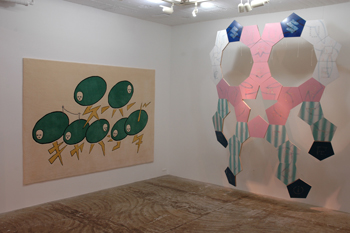 |
Focus features two in-depth reviews each month of fine art, architecture and design exhibitions and events at art museums, galleries and alternative spaces around Japan. The contributors are non-Japanese art critics living in Japan. |
|
|
 |
 |
 |
Tadasu Takamine: The Supercapacitor
Patrick Brzeski |
 |
|
|
|
 |
|
 |
Tadasu Takamine: The Supercapacitor
Installation view at ARATANIURANO, Tokyo, 2008
left: Untitled, 2008, h.163 x w.240 cm, wool
right: Untitled, 2008, h.240 x w.185 cm, lacquer paint on plywood |
|
Tadasu Takamine
Untitled, 2008,
h.65 x w.180 cm,
oil on panel
(detail) |
Artist as booster of esoteric, eco-friendly technology? Emphatically yes, apparently, at ARATANIURANO this month. Otsu-based artist Tadasu Takamine has staked all of his latest exhibition on the spirited advocacy of a single invention of electrochemical engineering, the titular supercapacitor, an energy-storing technology he believes could play a pivotal role in weaning the world's economies from their dependence on fossil fuels, improving our collective prospects for a greener, cleaner and cooler tomorrow.
Although he leaves us with some hint of a self-conscious understanding of the inherent limitations of gallery art's ability to manifest grand social change, I saw no reason not to take these new works in mixed media at face value. Takamine, an ever-adventurous and dexterous multi-media-ist, is here making a daring foray into cutting-edge environmental science, exploring a variety of modest visual schemes and promotional strategies to champion the supercapacitor and the implicit environmental values that stand behind its selection as the exhibition's raison d'être.
In place of an artist's statement Takamine has drafted a one-page primer on the supercapacitor, arguing for its transformative potential. To paraphrase, the supercapacitor is a powerful energy-storing device that confers great promise to the development of electric vehicles, weather-derived natural energy resources and nighttime electricity storage technologies. It holds some keen advantages over conventional chemical batteries, which are its principal rivals in practical application. Unlike batteries, supercapacitors are made from abundant and easy-to-dispose-of raw materials, are capable of short bursts of high energy (an essential requirement for many applications, such as sudden acceleration in an electric car), and don't degrade in a few short years, but have a lifespan of over a century. Takamine closes his statement lamenting the prohibitive expense of supercapacitors today, which he insists is impeding their immediate implementation and continued development.
Novel as it is to organize an exhibition around a technology really only known by experts, and noble as it is to put one's art to work for an invention believed to have the potential to effect the broad material change one's deeply felt values call for, Takamine has taken a pretty big risk here: if he's wrong about the supercapacitor, the whole show might feel like a bit of a folly.
Takamine's info-rich artist's statement is unreferenced. So after the usual compulsive wiki-search proved unenlightening, to get an authoritative take on the significance of the supercapacitor in the hope of better understanding Takamine's intentions, I took his text to Dr. Tetsuya Niikuni, an engineer in the Environment Research Department at the National Traffic Safety and Environment Laboratory of Japan.
Dr. Niikuni confirmed the accuracy of all of Takamine's substantive claims, but wondered over the choice of focusing on so specific a device. He observed that the supercapacitor is just one among many promising technologies in what is today one of the hottest but most difficult to predict fields of engineering. Takamine's writing is efflorescent with hope for the supercapacitor and a fast-coming revolution in associated alternative energy technologies, but according to Niikuni, no one really knows what energy storage system will prove most viable. As supercapacitors continue to be developed, new technical or financial limitations may unexpectedly arise, or a more practicable technology could suddenly come along. Somewhat tickled to be considering his field from the perspective of an artist, Niikuni offered one more, quite salient insight: "Perhaps what is unique about the supercapacitor, for the artist, is its super-sounding name."
We've all been exhaustively schooled by consumer culture to know what every successful PR campaign requires first: a snappy name. And "SUPERCAPACITOR" is just that (think power and crackling potential!). Perhaps Takamine intends the supercapacitor to serve as a synecdochal hook, seducing his audience into making private investigations that will increase their general awareness of the booming but still nascent field of green engineering. The exhibition would then best be understood as a mock multi-front PR effort, aimed at stimulating interest in carbon-free energy technology -- all done from the exiguous platform of a small commercial art gallery. So what then, finally, of the work itself?
Visually, it's all quite variegated (a mess, in fact) and suggests several distinct strategies of public promotion. A pair of anthropomorphized, animalic action figures serve as the mascots of the supercapacitor campaign and appear in assorted shapes and sizes throughout the show. Redolent of the DIY grass roots are a series of silkscreen posters and t-shirts announcing the supercapacitor in original fonts and repeated patterns. Three of the posters are done in bold colors and the others in natural browns; for the latter Takamine devised a mayonnaise-based silk-screening method. Slightly charred around the edges, the sepia-toned mayo posters look as if they were actually oven-baked into displaying their recurring patterns of text, all of which read "supercapacitor." Facing each other from opposite ends of the gallery, protruding from the walls in the proud, dauntless postures of superheroes, are two large action figures assembled from strung-together plywood pentagons, each individually painted by schoolchildren. These rather shoddily constructed sculptures are most interesting simply as evidence of Takamine's efforts at supercapacitor-themed educational outreach. An installation of cell phones and a holographic poster-board evoke slick, top-dollar commercial advertising. Using two red and green Softbank cell phones from the company's wildly popular Pantone series -- which ingeniously marketed its phones in a rainbow of color varieties and arrayed them as individual color swatches on display-boards that mimicked the paint displays of art and builder supply stores -- Takamine has put the vibrant phones to the very same imaginary art-use evinced by their ad campaign. The monitors of each phone flash simple animations starring the supercapacitor mascots. The hologram nearby coruscates from red to green, illuming the two faces of the action figures much like the animations do, thus smoothly maintaining the consistency of the supercapacitor brand.
In the exhibition's smallest and easiest to overlook work, we can discern a hint of Takamine's own self-conscious take on all these rehearsals in aesthetic eco-tech-boosterism. A symbolic cynosure of sorts, at the gallery's center sits a small, chocolate cast of a stamper, still half-enveloped in its white plaster mold, with the supercapacitor icons etched in its base. If one were to try to put this little artwork to its imagined practical use -- the imprinting of the artist's vision for the supercapacitor -- one would first have to pry it free from its mold, and after a few impressions it would soon crumble and melt. Bound by its formative white-walled context, and made as it is of the materials of mere sensory delectation, this art, Takamine is telling us, can only do so much. And so imprinted, the onus for the advancement of Takamine's dream of a world-remaking green technology sits with you, us, the audience.
 |
Tadasu Takamine: The Supercapacitor
Installation view at ARATANIURANO, Tokyo, 2008
left: Untitled, 2008, cell-phones, animation (free download)
right: Untitled, 2008, h.80 x w.120 cm, lenticular sheet, aluminum
|
|
|
All photos courtesy of ARATANIURANO.
|
|
|
 |
 |
 |
Tadasu Takamine: The Supercapacitor |
 |
ARATANIURANO |
 |
12 July - 6 September 2008 |
|
 |
 |
 |
Patrick Brzeski
Patrick Brzeski is a freelance writer and cultural critic based in Tokyo. Prior to his arrival in Japan three years ago, Patrick studied philosophy, literature and art history at the University of Wisconsin. He is an occasional contributor to magazines, journals and webzines in both the United States and Japan. |
|
 |
|